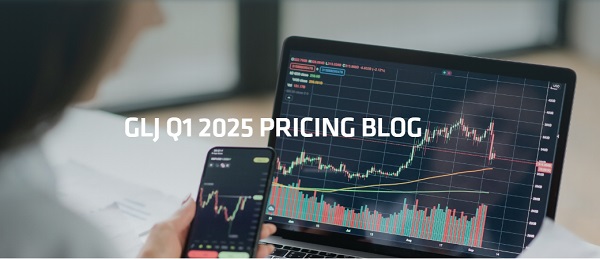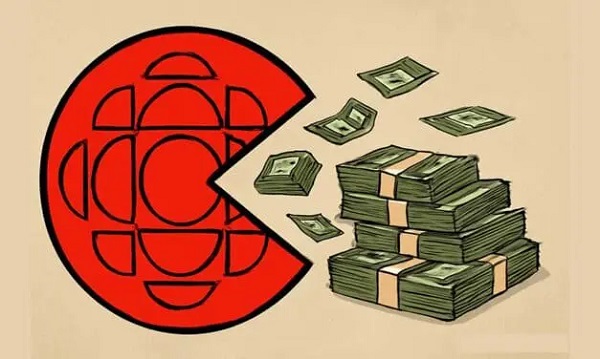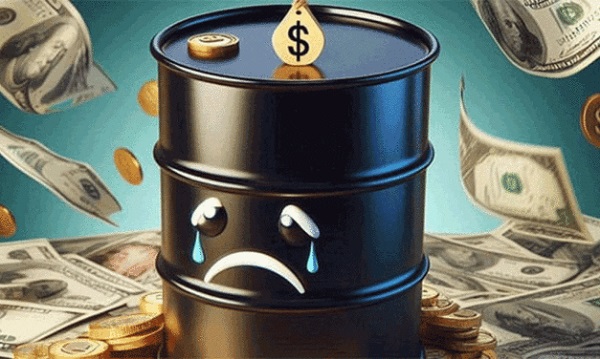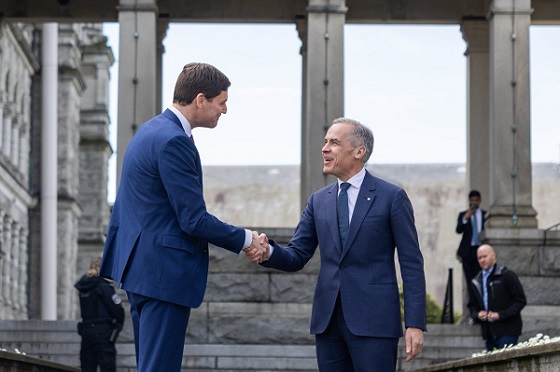Business
2025 Energy Outlook: Steering Through Recovery and Policy Shifts

From EnergyNow.ca
By Leonard Herchen & Yuchen Wang of GLJ
Their long-term real price forecast projects WTI at USD $74.00 per barrel and Henry Hub natural gas at USD $4.00 per MMBtu in 2025 dollars, signaling expectations of market stabilization and sustained global demand.
The energy markets in 2025 are undergoing transformative structural changes, highlighted by the operational launch of key infrastructure projects such as LNG Canada. This development significantly enhances Canada’s ability to meet rising global LNG demand while alleviating long-standing supply bottlenecks. At the same time, economic recovery across major markets remains uneven, shaping varied trends in energy demand and production activity.
Geopolitical dynamics are poised to redefine the competitive landscape, with the return of a Trump-led U.S. administration introducing potential shifts in trade policies, regulatory frameworks, and relationships with leading energy-producing nations. These changes, coupled with climate policy advancements and an accelerated global transition toward renewable energy, present additional complexities for the oil and gas sector.
Amid these uncertainties, GLJ’s analysts express confidence in the resilience of market fundamentals. Their long-term real price forecast projects WTI at USD $74.00 per barrel and Henry Hub natural gas at USD $4.00 per MMBtu in 2025 dollars, signaling expectations of market stabilization and sustained global demand.
Oil Prices
The oil market in 2025 reflects a delicate balance between supply and demand. During Q4 2024, WTI prices remained stable, fluctuating between $69 and $73 per barrel. This stability highlights the market’s resilience, even in the face of a slower global economic recovery and geopolitical challenges, including weaker demand in regions like China and increased production in North America.
Geopolitical risks remain pivotal, with ongoing tensions in the Middle East and sanctions on oil-exporting nations such as Iran and Venezuela threatening supply disruptions. While OPEC+ production cuts continue to provide vital support to prices by tightening global supply, these efforts are partially offset by the rising output of non-OPEC producers, notably in the U.S. and Canada.
The Trans Mountain Expansion (TMX) project is reshaping the pricing dynamics of WCS crude relative to WTI. By increasing export capacity to the West Coast, TMX has created conditions for a sustained narrowing of the WCS-WTI differential, moving away from seasonal fluctuations.
The return of a Trump-led U.S. administration introduces additional challenges. Deregulation policies aimed at boosting domestic oil production may exert downward pressure on prices, while potential trade tariffs and revised international agreements could further complicate global oil flows.
In this dynamic environment, GLJ forecasts WTI to average $71.25 per barrel and Brent $75.25 per barrel in 2025. These projections reflect robust long-term fundamentals, including sustained global demand and ongoing efforts to manage supply dynamics, emphasizing the market’s resilience despite near-term uncertainties.
Natural Gas Prices
In 2025, GLJ’s forecast suggests Henry Hub prices will average $3.20 per MMBtu, supported by steady domestic demand, seasonal winter peaks, and robust LNG exports. U.S. natural gas continues to play a critical role globally, ensuring supply security for key markets in Europe and Asia. The combination of growing industrial use, power generation demand, and stable production levels provides a solid foundation for price stability.
For the Canadian market, GLJ projects AECO natural gas prices to average $2.05 per MMBtu in 2025, representing a recovery from the lows of 2024. This improvement is attributed to easing regional oversupply and stabilizing demand. However, challenges persist, as production continues to outpace infrastructure expansion, prompting a downward adjustment of GLJ’s long-term AECO price forecast by $0.40 per MMBtu. The ramp-up of LNG Canada’s operations is expected to progressively enhance market dynamics and address these challenges.
On a global scale, LNG benchmarks such as NBP, TTF, and JKM have remained relatively stable, supported by high storage levels in Europe and balanced supply-demand conditions. European suppliers have effectively managed storage drawdowns, ensuring sufficient reserves for winter. Nevertheless, these benchmarks remain susceptible to market volatility driven by geopolitical uncertainties.
The CAD/USD Exchange Rate
The Canadian dollar experienced sharp depreciation during the last quarter of 2024, with the CAD/USD exchange rate falling below 0.70 USD. Economists have attributed this decline to the strength of the U.S. economy and its currency, the widening gap between the Bank of Canada and the U.S. Federal Reserve’s lending rates, as well as tariff threats and a political crisis in Ottawa. These factors have created a favorable environment for the U.S. dollar, putting downward pressure on the Canadian dollar.
Looking ahead to 2025, GLJ forecasts a CAD/USD exchange rate averaging 0.705 USD, underpinned by steady oil and gas revenues and enhanced export capacity from major projects such as LNG Canada and the TMX and eventual resolution of internal political issues and return to normalcy in US tariff policy.
Nevertheless, the outlook for the Canadian dollar remains uncertain, shaped by global economic recovery—particularly in China—and U.S. policy decisions under the Trump administration. While near-term challenges persist, Canada’s resource-driven economy and strategic energy export position provide a degree of resilience. In the absence of significant economic or geopolitical disruptions, GLJ projects the CAD/USD exchange rate to stabilize around 0.75 USD over the long term.
In 2025, GLJ expanded its database to include forecasts for Colombia Vasconia and Castilla Crude, as well as lithium prices, reflecting the increasing focus on diverse energy and resource markets. The addition of lithium forecasts aligns with the growing global emphasis on energy transition minerals critical for electric vehicles and battery storage solutions. A separate blog, set to be published next week on the GLJ website, will explore the lithium price forecast in greater depth, offering a detailed analysis and strategic implications for the energy sector.
GLJ’s forecast values for key benchmarks is as follows:

Business
The CBC is a government-funded giant no one watches

This article supplied by Troy Media.
 By Kris Sims
By Kris Sims
The CBC is draining taxpayer money while Canadians tune out. It’s time to stop funding a media giant that’s become a political pawn
The CBC is a taxpayer-funded failure, and it’s time to pull the plug. Yet during the election campaign, Prime Minister Mark Carney pledged to pump another $150 million into the broadcaster, even as the CBC was covering his campaign. That’s a blatant conflict of interest, and it underlines why government-funded journalism must end.
The CBC even reported on that announcement, running a headline calling itself “underfunded.” Think about that. Imagine being a CBC employee asking Carney questions at a campaign news conference, while knowing that if he wins, your employer gets a bigger cheque. Meanwhile, Conservative Leader Pierre Poilievre has pledged to defund the CBC. The broadcaster is literally covering a story that determines its future funding—and pretending there’s no conflict.
This kind of entanglement isn’t journalism. It’s political theatre. When reporters’ paycheques depend on who wins the election, public trust is shattered.
And the rot goes even deeper. In the Throne Speech, the Carney government vowed to “protect the institutions that bring these cultures and this identity to the world, like CBC/RadioCanada.” Before the election, a federal report recommended nearly doubling the CBC’s annual funding. Former heritage minister Pascale St-Onge said Canada should match the G7 average of $62 per person per year—a move that would balloon the CBC’s budget to $2.5 billion annually. That would nearly double the CBC’s current public funding, which already exceeds $1.2 billion per year.
To put that in perspective, $2.5 billion could cover the annual grocery bill for more than 150,000 Canadian families. But Ottawa wants to shovel more cash at an organization most Canadians don’t even watch.
St-Onge also proposed expanding the CBC’s mandate to “fight disinformation,” suggesting it should play a formal role in “helping the Canadian population understand fact-based information.” The federal government says this is about countering false or misleading information online—so-called “disinformation.” But the Carney platform took it further, pledging to “fully equip” the CBC to combat disinformation so Canadians “have a news source
they know they can trust.”
That raises troubling questions. Will the CBC become an official state fact-checker? Who decides what qualifies as “disinformation”? This isn’t about journalism anymore—it’s about control.
Meanwhile, accountability is nonexistent. Despite years of public backlash over lavish executive compensation, the CBC hasn’t cleaned up its act. Former CEO Catherine Tait earned nearly half a million dollars annually. Her successor, Marie Philippe Bouchard, will rake in up to $562,700. Bonuses were scrapped after criticism—but base salaries were quietly hiked instead. Canadians struggling with inflation and rising costs are footing the bill for bloated executive pay at a broadcaster few of them even watch.
The CBC’s flagship English-language prime-time news show draws just 1.8 per cent of available viewers. That means more than 98 per cent of TV-viewing Canadians are tuning out. The public isn’t buying what the CBC is selling—but they’re being forced to pay for it anyway.
Government-funded journalism is a conflict of interest by design. The CBC is expensive, unpopular, and unaccountable. It doesn’t need more money. It needs to stand on its own—or not at all.
Kris Sims is the Alberta Director for the Canadian Taxpayers Federation
Troy Media empowers Canadian community news outlets by providing independent, insightful analysis and commentary. Our mission is to support local media in helping Canadians stay informed and engaged by delivering reliable content that strengthens community connections and deepens understanding across the country.
Business
Trump family announces Trump Mobile: Made in America, for America

 MxM News
MxM News
Quick Hit:
On the 10-year anniversary of Donald Trump’s iconic campaign launch, the Trump family announced the debut of Trump Mobile, a new wireless company offering American-built smartphones, 5G coverage, and a values-driven alternative to Big Tech carriers.
Key Details:
-
Donald Trump Jr. and Eric Trump introduced Trump Mobile’s flagship service Monday, calling it a “transformational” alternative aimed at “our nation’s hardest-working people.”
-
The “47 Plan,” priced at $47.45/month, offers unlimited talk, text, and data, free international calls to U.S. military families, telehealth, roadside assistance, and no credit checks.
-
Trump Mobile’s customer support is fully U.S.-based and live 24/7—“not automated,” the company says—while a new American-made “T1 Phone” is slated for release in August.
Diving Deeper:
Marking ten years since President Donald Trump descended the golden escalator to launch his first campaign, the Trump Organization on Monday announced its boldest private sector move yet: Trump Mobile.
Flanked by company executives, Donald Trump Jr. and Eric Trump unveiled the new cellular service, touting it as a patriotic, people-first alternative to legacy providers. “We’re building on the movement to put America first,” Trump Jr. said in a statement. “We will deliver the highest levels of quality and service.”
The cornerstone of Trump Mobile is the 47 Plan. Offered for $47.45/month, the plan includes unlimited data, full 5G coverage across all three major carriers, and a suite of benefits tailored to middle-class families, truckers, veterans, and anyone tired of paying premiums to companies that don’t share their values.
Among the key perks: 24/7 American-based customer service (with “real people,” not bots), comprehensive device protection, roadside assistance through Drive America, and telehealth services including mental health support and prescription delivery. Most notably, the plan includes free international calling to over 100 countries—an effort the Trump family says honors U.S. military families stationed abroad.
“We’re especially proud to offer free long-distance calling to our military members and their families,” said Eric Trump. “Those serving overseas should always be able to stay connected to the people they love back home.”
Unlike traditional providers, Trump Mobile advertises no contracts and no credit checks, appealing to a demographic long underserved by mainstream telecom giants. “Hard-working Americans deserve a wireless service that’s affordable, reflects their values, and delivers reliable quality they can count on,” Eric Trump added.
The company is also preparing to launch the T1 Phone in August—a sleek, gold smartphone “engineered for performance” and “proudly designed and built in the United States.” With that, the Trump Organization is not just entering the mobile market—it’s staking a claim as a direct competitor to Apple and Samsung.
-

 Health21 hours ago
Health21 hours agoLast day and last chance to win this dream home! Support the 2025 Red Deer Hospital Lottery before midnight!
-

 Business2 days ago
Business2 days agoCarney’s European pivot could quietly reshape Canada’s sovereignty
-

 Aristotle Foundation1 day ago
Aristotle Foundation1 day agoThe Canadian Medical Association’s inexplicable stance on pediatric gender medicine
-

 Alberta2 days ago
Alberta2 days agoAlberta’s grand bargain with Canada includes a new pipeline to Prince Rupert
-

 conflict1 day ago
conflict1 day ago“Evacuate”: Netanyahu Warns Tehran as Israel Expands Strikes on Iran’s Military Command
-

 Energy1 day ago
Energy1 day agoCould the G7 Summit in Alberta be a historic moment for Canadian energy?
-

 Crime1 day ago
Crime1 day agoMinnesota shooter arrested after 48-hour manhunt
-

 Bruce Dowbiggin1 day ago
Bruce Dowbiggin1 day agoWOKE NBA Stars Seems Natural For CDN Advertisers. Why Won’t They Bite?





